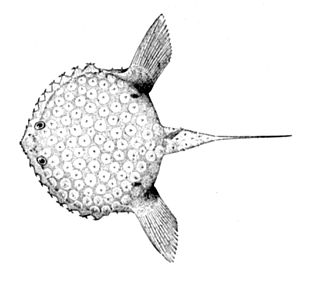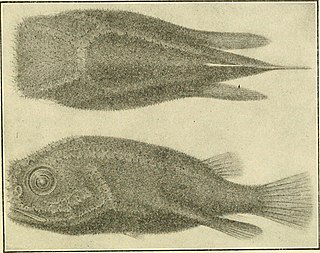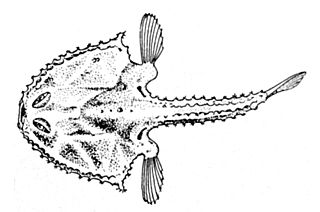
The pancake batfish, Atlantic pancake batfish, Louisiana pancake batfish or spiny batfish, is a species of marine ray-finned fish belonging to the family Ogcocephalidae, the deep sea batfishes or seabats. This species is found in the Western Atlantic Ocean.

Ogcocephalidae is a family of anglerfish specifically adapted for a benthic lifestyle of crawling about on the seafloor. Ogcocephalid anglerfish are sometimes referred to as batfishes, deep-sea batfishes, handfishes, and seabats. They are found in tropical and subtropical oceans worldwide. They are mostly found at depths between 200 and 3,000 m, but have been recorded as deep as 4,000 m (13,000 ft). A few species live in much shallower coastal waters and, exceptionally, may enter river estuaries.

The starry handfish, starry seabat or minipizza batfish, is species of marine ray-finned fish belonging to the family Ogcocephalidae, the deep-sea batfishes or seabats. This fish is found on the continental shelves of the Indo-Pacific oceans at depths of between 50 and 400 m. They are up to 30 cm long.

Halieutichthys is a genus of marine ray-finned fishes belonging to the family Ogcocephalidae, the deep-sea batfishes or sea bats. The fishes in this genus are found in the western Atlantic Ocean.

Halieutopsis is a genus of marine ray-finned fishes beloning to the family Ogcocephalidae, the deep sea batfishes. The species in this genus are found in the Indian and Pacific Oceans.

Coelophrys is a genus of marine ray-finned fishes belonging to the family Ogcocephalidae, the deep-sea batfishes or sea bats. The fishes in this genus are found in the western Pacific Ocean and the Indian Ocean.

Halicmetus is a genus of marine ray-finned fishes belonging to the family Ogcocephalidae, the deep sea batfishes. The fishes in this genus are widely distributed in the Indian and Western Pacific Oceans.

Halieutaea is a genus of marine ray-finned fishes belonging to the family Ogcocephalidae, the deep sea batfishes. These fishes are found in the Indian and Western Pacific Oceans.
Halieutichthys bispinosus, the two-spine batfish or spiny batfish, is a species of marine ray-finned fish belonging to the family Ogcocephalidae, the deep sea batfishes or seabats. This species is found in the Western Atlantic Ocean.
Ogcocephalus porrectus, the rosy-lipped batfish, is endemic to Cocos Island off the Pacific coast of Costa Rica. Though members of Ogcocephalidae occur in tropical, warm waters in both the Western Atlantic and Eastern Pacific. Rosy-lipped batfish generally reside in shallow to deep water benthic zones with a bathymetric range of 35 – 150 m. The syntypic series was collected at 120 m on a rocky bottom. What makes this fish distinctive are its rosy red lips, specialized pectoral fins used for "walking", and an illicium used for attracting prey.

The Atlantic batfish is a species of marine ray-finned fish belonging to the family Ogcocephalidae, the deep-sea batfishes. It is found in deep water in the Atlantic Ocean where it lives on the seabed, feeding on small invertebrates.

Halieutopsis andriashevi, Andriashev's deepsea batfish, is a species of ray-finned fish belonging to the family Ogcocephalidae, the deep sea batfishes. This fish is found in the western Indian Ocean.

Halieutopsis bathyoreos, broad-snout deepsea batfish, is a species of ray-finned fish belonging to the family Ogcocephalidae, the deep sea batfishes. This fish is has a widespread distribution in deeper waters in the Indo-West Pacific region as far east as Hawaii.
Halieutopsis ingerorum, Ingers' deepsea batfish, is a species of ray-finned fish belonging to the family Ogcocephalidae, the deep sea batfishes. This fish is found in the Western Indian Ocean.
Halieutopsis echinoderma, the spiny deepsea batfish, is a species of ray-finned fish belonging to the family Ogcocephalidae, the deep sea batfishes. This fish is found in the Western Pacific Ocean.
Halieutopsis margaretae, Margaret's deepsea batfish, is a species of ray-finned fish belonging to the family Ogcocephalidae, the deep sea batfishes. This fish is found in the Western Pacific Ocean.

Halieutopsis nasuta, the big-nosed deepsea batfish, is a species of ray-finned fish belonging to the family Ogcocephalidae, the deep sea batfishes. This fish is found in the Indian and Pacific Oceans. H. nasuta is classified within the genus Dibranchus by some authorities, but is generally considered to belong in the genus Halieutopsis.
Dibranchus tremendus is a species of marine ray-finned fish belonging to the family Ogcocephalidae, the deep-sea batfishes. It is found in deep water in the Atlantic Ocean. This species was identified as a different species from Dibranchus atlanticus in 1999. It is the largest species in its genus.

Halieutaea indica, the Indian batfish, Indian handfish or Indian seabat, is a species of marine ray-finned fish belonging to the family Ogcocephalidae, the deep sea batfishes. The Indian batfish has a wide Indo-West Pacific distribution.

The Caribbean batfish, also known as the two-spine batfish, is a species of marine ray-finned fish belonging to the family Ogcocephalidae, the deep sea batfishes or seabats. This species is found in the Western Atlantic Ocean.













